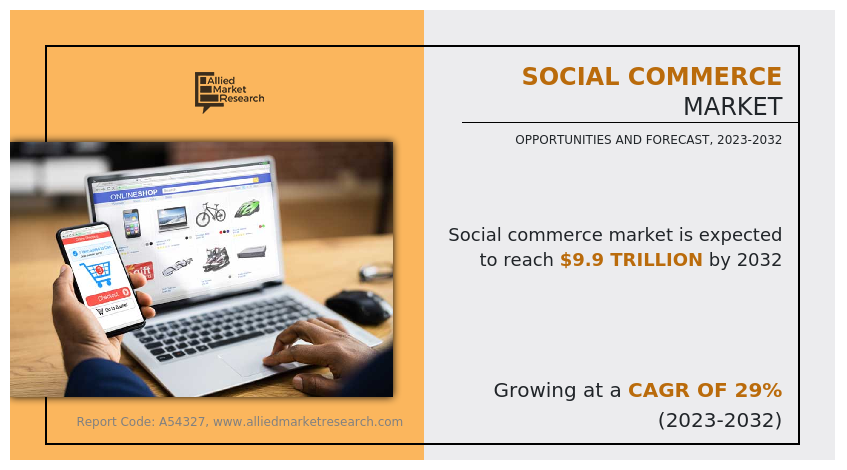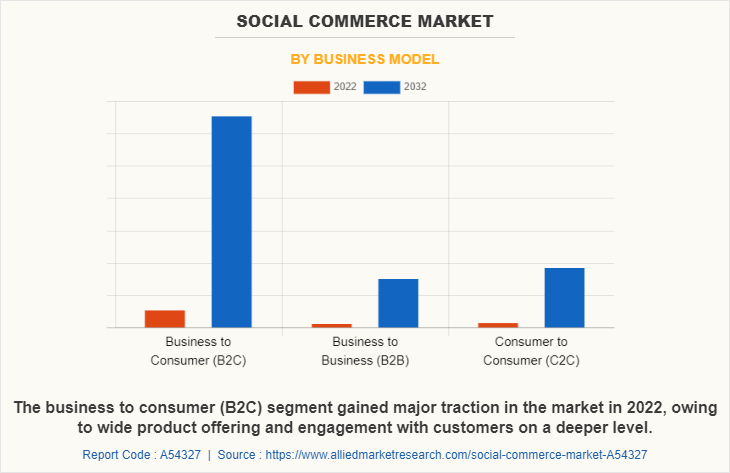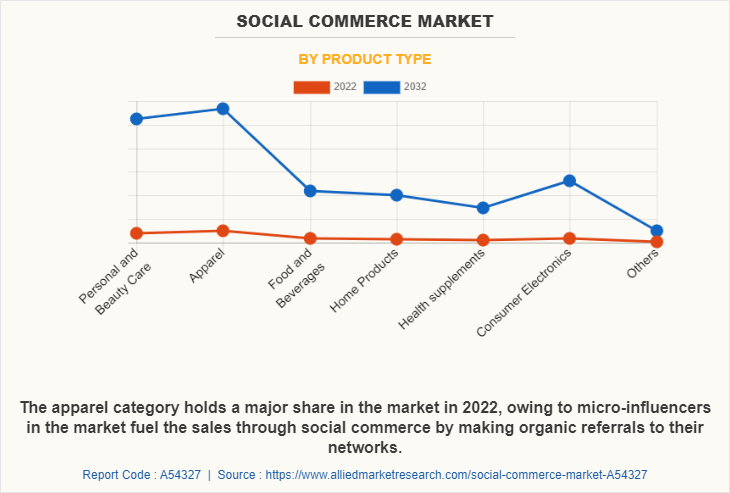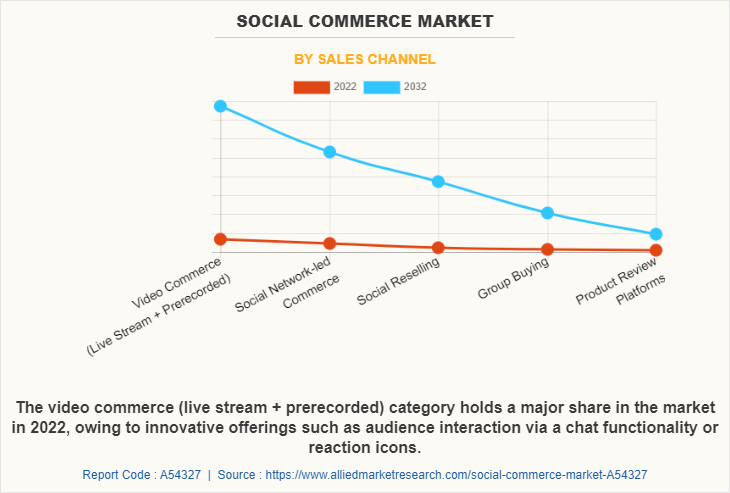Social Commerce Market Research, 2032
The global social commerce market size was valued at $784 billion in 2022, and is projected to reach $9864.6 billion by 2032, growing at a CAGR of 29% from 2023 to 2032.The utilization of social networking sites such as Facebook and Instagram to promote and sell items and services is known as social commerce. By using this strategy, the company ensures that the majority of the customers complete purchases without exiting social networking apps. Customers browse a brand's content before visiting its website to begin buying in social commerce, which differs from traditional social media marketing approaches. Instead, social media platforms such as Facebook Marketplace and Instagram live stores function as virtual storefronts.

The expansion and increase in appeal of e-commerce are significant drivers driving the expansion of the social commerce industry, with video commerce being the fastest-growing sector. Many retail players are now running web-based retail storefronts where shoppers may discover the company and its items. The availability of different product categories such as apparel, cosmetics, and others along with price comparison on internet platforms is also increasing the number of online purchases made by customers. This is advantageous to the main players, since it eliminates the need for physical outlets or stores while also allowing customers to read reviews offered by other individuals and compare various retailers, products, and the prices of multiple vendors for certain food essentials.
Consumers were compelled to migrate to internet purchasing owing to the COVID-19 outbreak. According to the United Nations Conference on Trade and Development (UNCTAD), the e-commerce business increased in 2021, with online retail sales growing from 16% to 19% of total retail sales, and online retail sales increased by 21% in 2022. According to the study, the Republic of Korea saw the biggest percentage increase in online retail sales, rising from 20.8% in 2019 to 28.7% in 2021. The rising proportion indicates that people are migrating towards internet purchasing, and its popularity is growing. The increased availability of internet connection and customer acceptance of online shopping owing to advantages such as convenience, time savings, and lower pricing is projected to drive the social commerce market growth
Digital marketing is the advertising of products or services using new technology, particularly the Internet, and through numerous means such as cell phones, display adverts, and all other digital and social media. Influencers are collaborating with companies to promote personal & beauty care products on social media and cosmetics companies spending a lot of money on digital marketing to raise awareness about the benefits of using vegan cosmetics.
Additionally, with the increasing demand for cosmetics in the market, celebrities are entering the market with their cosmetics brand to offer a unique experience to consumers. For instance, influencers such as Selena Gomez, Lady Gaga, Gwen Stefani, and others, have launched their brand in the vegan cosmetics industry. They are adding tags such as cruelty-free and 100% vegan, since they help to pique the interest of consumers. Furthermore, the e-commerce platforms are providing an opportunity for the environment conscious skincare companies to be accessible for the global consumers, therefore it is assisting in the rise of popularity of sustainable beauty. Consumers' interest in vegan beauty companies is growing faster than that in traditional beauty goods due to the rising influence of social media sites.
The COVID-19 outbreak has benefited the social commerce industry as people have become increasingly reliant on social networking sites to stay in touch with families and closest ones as they have been forced to stay at home and avoid overcrowded venues. Due to the increased use of social media, businesses have discovered new opportunities to engage and interact with customers through social commerce efforts. Instagram and Facebook have introduced new facilities to make it easier for businesses to sell items directly through their respective web pages and many businesses have taken advantage of these capabilities to improve their online visibility. The epidemic has also had an impact on consumer behavior, with many people getting comfortable with and favoring online shopping over traditional brick-and-mortar stores.
The concerns of data privacy and the increase in risk of data breaches are major concerns for consumers who are associated with the e-commerce and social commerce market. Numerous individuals are cautious to share their financial and personal details with businesses, especially in light of recent prominent data thefts and cyber assaults that have exposed consumer data. Consumers are unwilling to participate in social shopping sites as a result of this lack of confidence, restricting the growth and acceptance of these channels.
Furthermore, the danger of data breaches has major financial and reputational ramifications for firms. A data breach occurs in the theft of confidential consumer data, which results in legal penalties, loss of customer confidence, and brand reputation harm. Furthermore, the expenses of data breaches, such as remediation costs and notification and credit surveillance services, have a significant impact on the firm and the global social commerce sales & development.
Augmented reality (AR) is an innovation that augments the physical world by superimposing digital data and images on it. AR technology operates by tracking the user's surroundings and overlaying digital data in real time by using sensor technology, cameras, and other devices. AR technology integration is projected to dramatically improve the sector of e-commerce and social commerce by giving shoppers a more compelling and realistic buying experience. Customers may be able to observe and communicate with items in a real-world setting using augmented reality, allowing consumers to see how things might appear and fit in their surroundings. It is anticipated to bridge the distinction between both online and traditional purchasing, by providing a realistic visual of the products under a single click.
AR promises to minimize logistics errors by letting buyers preview things before purchasing, lowering the chance of purchasing products that do not fulfill their expectations. This may assist businesses and customers equally to decrease the expense and difficulty of returns. Furthermore, in recent years, augmented reality has allowed businesses to separate themselves from their competition by offering an exclusive and novel buying experience. This has aided organizations in increasing consumer engagement, commitment, and retention, which has resulted in greater sales and income. The incorporation of AR technology has transformed the e-commerce business by offering shoppers a more personalized and immersive buying experience, and it is expected to provide the global market opportunities to flourish.
Segmental Overview
The social commerce market is segmented into business model, product type, sales channel, and region. By business model, the market is classified into business to consumer (B2C), business to business (B2B), and consumer to consumer (C2C). By product type, the market is classified into personal and beauty care, apparel, food & beverages, home products, health supplement, consumer electronics, and others. By sales channel, the market is divided into video commerce (live stream + prerecorded), social network-led commerce, social reselling, group buying, and product review platform. Region-wise, the market is analyzed across North America (the U.S., Canada, and Mexico), Europe (UK, Germany, France, Spain, Italy, and the rest of Europe), Asia-Pacific (China, Japan, India, South Korea, Australia, and the rest of Asia-Pacific), and LAMEA (Brazil, South Africa, Saudi Arabia, Turkey, and rest of LAMEA).
By Business Model
On the basis of business model, the business to consumer segment gained a major share of the global market in 2022, and is expected to sustain its market share during the forecast period. B2C social commerce sites provide a number of resources and tools to assist businesses in advertising and marketing their products to customers. The B2C business model provides services such as listings for goods, evaluations, opinions, social media sharing options, and payment processing systems. Furthermore, businesses may employ these types of technologies to develop entertaining and engaging purchasing experiences for prospects, which aids in customer retention and sales growth.

By Product Type
According to the social commerce market demand, on the basis of product type, the apparel segment dominated the market in 2022, and is expected to sustain its market share during the forecast period. Apparel firms are performing live-stream for product presentations by forming agreements with prominent social influencers to provide an experience that includes rapid buying of a showcased product and audience interaction through chat or response buttons. Furthermore, Key Opinion Consumers" (KOCs) have a considerable effect on the sales of products and brand reputations in the garment business. These micro-influencers fuel social commerce by making organic referrals to their networks.

By Sales Channel
On the basis of sales channel, the video commerce (live stream + prerecorded) segment dominated the market in 2022 and is expected to sustain its market share during the forecast period. Live commerce is engaging and engrossing, which keeps individuals interested and helps to increase the overall watch time of the live streaming. It also narrows client choice paths from understanding to making a purchase decision. Furthermore, live commerce integrates rapid product purchases with audience interaction via a chat functionality or reaction icons. Therefore, the rate of conversion for social commerce enterprises has reached 30% employing time-limited techniques, which is up to 10 times greater than for traditional e-commerce.

By Region
According to the region, Asia-Pacific dominated the global market in 2022 and is expected to be dominant during the social commerce market forecast period. China emerged as the largest market for social commerce in Asia-Pacific as well as in the global scenario. The rise of social commerce in China provides an understanding of the potential, as corporations in China form alliances with hugely successful social influencers and engage in live-stream shopping events. Live-stream shopping provides consumers with a shopping experience that blends fast buying of a highlighted product with audience engagement via chat or reaction buttons.

Competition Analysis
Players operating in the global social commerce market have adopted various developmental strategies to expand their social commerce market share, increase profitability, and remain competitive in the market. Key players profiled in this report include Verint Systems Inc., Snap, Inc., Trell Experience Pvt Ltd., Etsy, Inc., Poshmark, Inc., Inmobi Pte Ltd., Yunji Inc, Meta Platforms, Inc., Twitter, Inc., Alibaba Group Holding Limited, Pinduoduo Inc., ByteDance, Amazon.com, Inc., and Pinterest, Inc.
Some Examples of Acquisition in The Market
In March 2023, Snap, Inc., acquired Th3rd, which is a 3D scanning technology company. This acquisition will expand its augmented reality based commerce business and will further strengthen its business position in the social commerce market.
In October 2022, Pinterest, Inc., acquired THE YES, which is an Artificial intelligence-powered shopping platform. This acquisition will strengthen its business position in the global market and will further introduce new innovative technology and expertise enhancing the company's objective of providing taste-driven shopping.
In September 2022, Meta Platforms, Inc., acquired Lofelt, which is a software and technology startup engaged in virtual reality solutions. This acquisition will strengthen its business position in the virtual reality market.
In February 2022, Meta Platforms, Inc., acquired Kustomer, which is a consumer services software company. This acquisition will contribute to its current technology base for messaging applications and will further bring improvements in its messaging platforms.
Some Examples of Product Launch in The Market
In April 2023, Meta Platforms, Inc., introduced Managed Partner Ads Lite, which is a tool mainly marketed towards retailers and e-commerce advertisers. This launch will expand its portfolio in retail media marketing.
In April 2023, Taobao, a division of Alibaba Group Holding Limited, introduced a new sales channel. This channel will be displayed on the homepage and will mainly focus on cost-effectiveness and free shipping. This expanded its current services offered to its users on the platform.
In March 2023, Snap, Inc., introduced a new business AR Enterprise Services, which is mainly directed toward retailers to make use of augmented reality and artificial intelligence shopping tools. This launch will expand its current services offering.
In December 2022, Amazon.com, Inc., announced that it will launch a new application for enhancing the shopping experience, which will allow users to create and consume short video formats. This launch will strengthen its business position in the social commerce market.
Key Benefits For Stakeholders
- This report provides a quantitative analysis of the market segments, current trends, estimations, and dynamics of the social commerce market analysis from 2022 to 2032 to identify the prevailing social commerce market opportunities.
- The market research is offered along with information related to key drivers, restraints, and opportunities.
- Porter's five forces analysis highlights the potency of buyers and suppliers to enable stakeholders make profit-oriented business decisions and strengthen their supplier-buyer network.
- In-depth analysis of the social commerce market segmentation assists to determine the prevailing market opportunities.
- Major countries in each region are mapped according to their revenue contribution to the global market.
- Market player positioning facilitates benchmarking and provides a clear understanding of the present position of the market players.
- The report includes the analysis of the regional as well as global social commerce market trends, key players, market segments, application areas, and market growth strategies.
Social Commerce Market Report Highlights
| Aspects | Details |
| Market Size By 2032 | USD 9864.6 billion |
| Growth Rate | CAGR of 29% |
| Forecast period | 2022 - 2032 |
| Report Pages | 381 |
| By Business Model |
|
| By Product Type |
|
| By Sales Channel |
|
| By Region |
|
| Key Market Players | Yunji Inc., Poshmark, Inc., Meta Platforms, Inc., Pinduoduo Inc., Pinterest, Inc., Amazon.com, Inc., Snap, Inc., ByteDance, Tencent Holdings Limited, Alibaba Group Holding Limited, Etsy, Inc., Trell Experiences Pvt Ltd., Twitter, Inc., InMobi Pte Ltd, Verint Systems Inc. |
Analyst Review
According to CXOs, social commerce is the upcoming digital buying revolution, a revolution that will alter people's purchasing habits as deeply as internet shopping has over the previous two decades. The consistent increase in social media time demonstrates the significance of these online communities in an individual's life. Social media platforms and applications are transforming how consumers purchase and sell, providing platforms and companies with novel experiences and income sources.
Furthermore, mobile commerce cultures such as China, India, and Brazil have seen new market growth and evolution in purchasing methods from physical retail to e-commerce, but consumers are currently shifting from e-commerce to social commerce at an even quicker pace than the previous shift that occurred in Western nations. Furthermore, firms who were early adopters of social commerce understand its potential. For instance, Sephora pioneered Instagram purchasing, allowing shoppers to make purchases directly from the Instagram app. In 2021, the firm collaborated with Facebook on a weekly series of live-stream shopping programs.
CXOs further stated that social commerce serves as a democratizing force propelled by creativity, innovation, and the authority of the people. It empowers small businesses and people while forcing large corporations to reconsider their significance. The ramifications will affect every consumer category, every item or service, and every platform, brand, and store. New and established market participants must work hard to innovate their approaches and accept the rich ecosystem with fresh alliances and business models.
The social commerce market size was valued at $784,017.0 million in 2022 and is projected to reach $9,864,634.9 million by 2032, growing at a CAGR of 29.0% from 2023 to 2032.
The global social commerce market registered a CAGR of 29.0% from 2023 to 2032.
Raise the query and paste the link of the specific report and our sales executive will revert with the sample.
The forecast period in the social commerce market report is from 2023 to 2032.
The top companies that hold the market share in the social commerce market include Etsy, Inc., Poshmark, Inc., Meta Platforms, Inc, Amazon.com, Inc., and Pinterest, Inc.
The social commerce market report has 3 segments. The segments are business model, product type, and sales channel.
The emerging countries in the social commerce market are likely to grow at a CAGR of more than 33.0% from 2023 to 2032.
Post-COVID-19, the expansion of live stream shopping, mobile commerce, and social resale has been exponential, making it one of the cornerstones of the social commerce sector. The increasing acceptance of live commerce is likely to boost the market development of social commerce in the upcoming years.
Asia-Pacific will dominate the social commerce market by the end of 2032.
Loading Table Of Content...
Loading Research Methodology...



